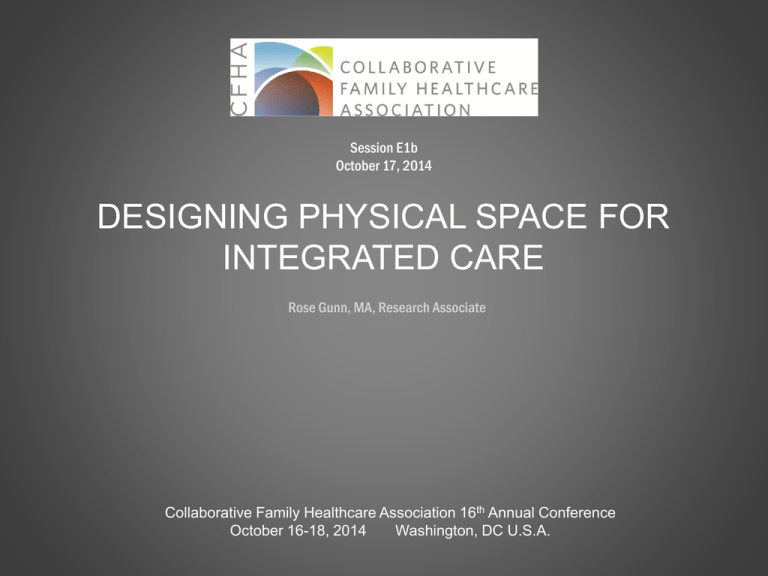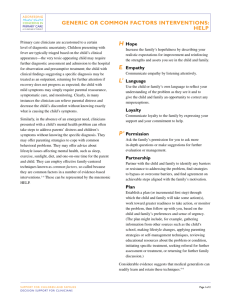E1b - Collaborative Family Healthcare Association
advertisement

Session E1b October 17, 2014 DESIGNING PHYSICAL SPACE FOR INTEGRATED CARE Rose Gunn, MA, Research Associate Collaborative Family Healthcare Association 16th Annual Conference October 16-18, 2014 Washington, DC U.S.A. LEARNING OBJECTIVES AT THE CONCLUSION OF THIS SESSION, THE PARTICIPANT WILL BE ABLE TO: Identify spatial configurations that support collaboration and coordination of integrated teams. Identify spatial configurations that present barriers to integration. Discuss the tension that exists between designing space that supports teamwork as well as allowing for private, focused care and describe how sites address these tensions. Discuss how improving physical layout in integrated settings can address the Triple Aim. FACULTY DISCLOSURE We have not had any relevant financial relationships during the past 12 months. Bibliography / Reference 1. Bleakley, A. (2013). "The dislocation of medical dominance: making space for interprofessional care." Journal of Interprofessional Care 27 Suppl 2: 24-30. 2. Gulwadi, G.B., et al. 2009. “Exploring the impact of the physical environment on patient outcomes in ambulatory care settings.” Health Environments Research and Design Journal 2(2): 21-41. 3. Gum LF, et al. 2012. “From the nurses' station to the health team hub: how can design promote interprofessional collaboration?” Journal of Interprofessional Care. 2012 Jan;26(1):21-7. 4. Scharf DM, et al. 2013 “Integrating primary care into community behavioral health settings: programs and early implementation experiences”. Psychiatr Serv. 2013 Jul 1;64(7):660-5. 5. Lamb G, Shraiky J. 2013 “Designing for competence: spaces that enhance collaboration readiness in healthcare. J Interprof Care. Sep;27 Suppl 2:14-23. LEARNING ASSESSMENT A learning assessment is required for CE credit. A question and answer period will be conducted at the end of this presentation. ACKNOWLEDGMENTS Much gratitude and respect for our research partners: the 18 practices that shared their lived experiences with us. Thank you, as well, to Deborah Cohen, PhD, Melinda Davis, PhD, Jennifer Hall, MPH, John Heintzman, MD, Ben Miller, PsyD, John Meunch, MD, and Brianna Smeds, AIA BACKGROUND Layout of space in integrated clinics can present challenges to successful integration or serve to strengthen these models. Different spatial arrangements can influence team dynamics and share examples of how primary care practices adapt their spaces to better support collaboration among professionals. METHODS •Sample of 19 integrated primary care practices in the US •11 were new to integrating care •8 were considered established integrated clinics •Research team visited the clinics and observed clinical operations •8-12 interviews with leaders, providers, and staff at each site •Data analyzed by a multidisciplinary team using a grounded theory approach •Study protocol was approved by the Institutional Review Board at Oregon Health & Science University RESULTS Examination of physical layout in integrated clinics in team workspace, clinician offices, and location of support staff fall in 3 broad categories: Central medical assistant station with exam rooms and individual office space for primary care clinicians surrounding this “patient hub.” Behavioral health clinicians are also assigned private office space, frequently located at a distance from the central patient care areas. Shared office space for behavioral health and primary care clinicians. Medical assistants and other support staff may be co-located in this shared space or in a separate office cluster near the exam rooms. Integrated pods that allow medical clinicians, behavioral health staff, and medical assistants to interact fluidly in a central area around a cluster of exam rooms. RESULTS • These three spatial arrangements were closely associated with a team’s ability to easily and fluidly collaborate and coordinate to provide integrated care. CLOSE PROXIMITY allowed teams to establish situational awareness; an understanding of the flow and tasks in which other members of the care team are involved. fostered a team dynamic that promoted collaboration rather than working individually to address patient needs. CHALLENGES AND STRATEGIES Close proximity also presented challenges for patient privacy and clinicians finding “private space” to consult or complete quieter tasks. Strategies such as using white noise machines or having additional exam rooms where private conversations could occur were employed in these situations. While physical layout promoted collaboration among the clinical teams, sites also implemented communication strategies to bridge spatial divides, such as inbox messaging, Vocera communication systems, phones, and internal messaging systems. DISCUSSION • Many practices that aspire to provide integrated models of care do not often have the luxury of creating new facilities from the ground up; they have to make do with the space available to them. • Observation shows that physical space was designed to manage a tension between requirements for private space for patients and clinicians and the need for shared team workspace that enables collaboration. DISCUSSION • Challenges can be ameliorated by a number of strategies including designing compact work areas that allow providers easy access to one another and close proximity of patient rooms to team workspace. • Being intentional and thoughtful about design and physical layout of work spaces for teams, individual clinicians, and clinical support staff is a critical component for implementing integrated care. Space, space: architects always talk about space! But creating a space is not automatically doing architecture. With the same space, you can make a masterpiece or cause a disaster. Each new situation requires a new architecture. -Jean Nouvel SESSION EVALUATION Please complete and return the evaluation form to the classroom monitor before leaving this session. Thank you!











